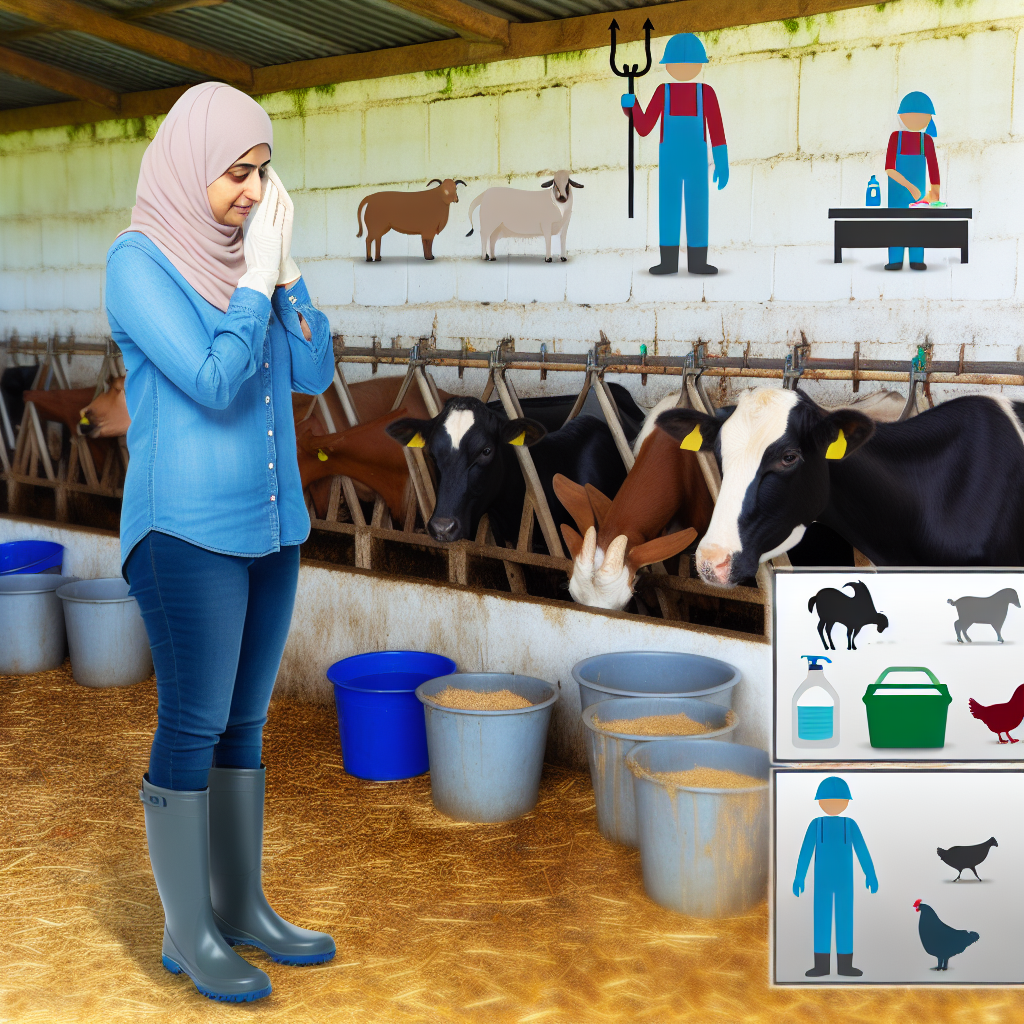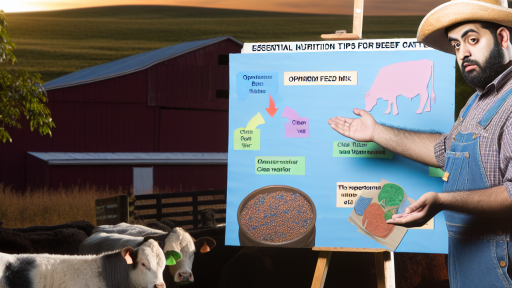Introduction to Livestock Handling and its Importance in Agricultural Safety
Livestock handling plays a crucial role in agricultural settings.
Effective handling methods ensure the safety of both animals and handlers.
Moreover, proper techniques promote animal welfare and productivity.
Farmers and ranchers must understand the risks associated with livestock handling.
Inadequate training can lead to serious injuries or accidents.
Understanding Common Risks
Handling livestock involves various risks that can escalate quickly.
Animals may become agitated or frightened during handling.
This agitation can result in unexpected movements or aggressive behavior.
Handlers must be alert to the potential for kicks, bites, or trampling.
Establishing Safe Handling Protocols
Protocols are essential to mitigate risks during livestock handling.
First, handlers should always use the appropriate equipment.
Utilizing chutes, gates, and fences can keep both animals and handlers safe.
Additionally, handlers should work in pairs to maintain control.
Effective communication among team members enhances safety.
The Role of Training and Education
Ongoing training programs are vital for livestock handling safety.
Transform Your Agribusiness
Unlock your farm's potential with expert advice tailored to your needs. Get actionable steps that drive real results.
Get StartedParticipants should learn the basics of animal behavior and handling techniques.
Education helps prevent accidents and improves animal management.
Farms should encourage regular workshops or seminars on safety practices.
Such initiatives foster a culture of safety within the agricultural community.
Promoting a Safe Work Environment
Creating a safe environment is an ongoing process.
Regular assessments of handling facilities can identify hazards.
Proper maintenance of equipment and pens ensures safety standards are met.
Farmers should encourage reporting of unsafe conditions or practices.
This proactive approach enhances overall safety for all involved.
Overview of Health Risks Associated with Livestock Handling
Physical Injuries
Handling livestock can lead to physical injuries for workers.
Animals may kick, bite, or charge if they feel threatened.
Injuries commonly include bruises, fractures, and abrasions.
Proper training and awareness can mitigate these risks.
Transmission of Zoonotic Diseases
Livestock can carry diseases that are transmissible to humans.
Common zoonotic diseases include brucellosis and leptospirosis.
Infectious agents can spread through direct contact or contaminated surfaces.
Maintaining hygiene and using protective gear is essential.
Respiratory Issues
Dust, mold, and animal dander can trigger respiratory issues.
Workers may develop conditions like asthma or chronic bronchitis.
Regular cleaning and proper ventilation can help reduce exposure.
Allergenic Reactions
Some individuals may experience allergic reactions when handling livestock.
Common allergens include animal saliva, urine, and feces.
Wearing appropriate clothing can minimize skin contact and exposure.
Psychological Stress
Livestock handling can also impose psychological stress on workers.
Showcase Your Farming Business
Publish your professional farming services profile on our blog for a one-time fee of $200 and reach a dedicated audience of farmers and agribusiness owners.
Publish Your ProfileWorkers may face anxiety due to the unpredictability of animal behavior.
Creating a supportive work environment can alleviate some stress.
Preventive Measures
Implementing preventive measures can enhance safety during livestock handling.
- Utilize appropriate equipment for moving and restraining animals.
- Provide thorough training programs for all employees.
- Encourage regular health check-ups for workers.
- Maintain a clean and organized workspace to minimize hazards.
Awareness and proper practices can significantly reduce health risks.
Essential Personal Protective Equipment (PPE) for Livestock Handlers
Importance of PPE
Personal protective equipment plays a crucial role in livestock handling.
This equipment minimizes the risk of injury and illness.
Moreover, PPE helps ensure the safety of workers and animals.
Types of Essential PPE
Handlers should wear appropriate headgear for protection.
Hard hats are essential in preventing head injuries.
Furthermore, face shields can protect against flying debris.
Next, eye protection is vital when working with livestock.
Goggles or safety glasses help protect against injury.
They shield the eyes from potential hazards in the environment.
Proper footwear is another key element of PPE.
Sturdy, non-slip boots provide safety on slippery surfaces.
These boots also protect the feet from heavy objects.
Handlers must always use appropriate gloves during handling.
Gloves protect against diseases and sharp objects.
They also provide better grip when handling animals.
Additional Recommended Equipment
Hearing protection may be necessary in loud environments.
Earplugs or earmuffs help protect against hearing loss.
High-visibility clothing is essential for safety.
This clothing ensures that handlers are seen in low-light conditions.
It helps prevent accidents when working near vehicles.
Maintaining PPE
Regularly inspect all PPE for wear and tear.
Damaged equipment should be repaired or replaced immediately.
Additionally, proper cleaning and storage extend the lifespan of PPE.
Delve into the Subject: Genetic Factors Influencing Livestock Fertility
Best Practices for Approaching and Handling Different Types of Livestock
General Safety Guidelines
Always assess the animal’s demeanor before approaching.
Maintain a calm and quiet environment during handling.
Use appropriate personal protective equipment to stay safe.
Approach animals slowly to avoid startling them.
Be aware of your body language; animals respond to it.
Keep your hands visible to assure them you mean no harm.
Handling Cattle
Use low-stress techniques when moving cattle.
Always position yourself in a safe location while working.
Utilize proper head gates for safer handling of individual animals.
When leading, use a halter that fits snugly but isn’t tight.
In crowded situations, move quietly to maintain control.
Handling Sheep
Approach sheep from the front to prevent surprises.
Showcase Your Farming Business
Publish your professional farming services profile on our blog for a one-time fee of $200 and reach a dedicated audience of farmers and agribusiness owners.
Publish Your ProfileUse gentle pressure to guide them rather than force.
Keep the flock together; isolation can cause stress.
Utilize a capture pen to safely manage sheep movements.
Handle them quickly and confidently to minimize anxiety.
Handling Goats
Use treats as incentives to build trust with goats.
Be cautious; goats can be curious and unpredictable.
Ensure adequate space to avoid confrontations between animals.
Utilize sturdy fencing to prevent escapes.
When catching, keep the goat’s head low for easier control.
Handling Swine
For pigs, noise can be alarming; remain quiet.
Use slow and deliberate movements when interacting.
Provide ample space, as pigs can become aggressive if cornered.
Always secure their front legs when handling for safety.
Employ rattle paddles to guide them gently without stress.
Handling Horses
Approach horses from the front left side for safety.
Speak softly to ease their apprehension during handling.
Use proper equipment, like halters and lead ropes.
Be aware of their blind spots to avoid surprises.
Stay alert for signs of discomfort or agitation in horses.
Discover More: Crossbreeding vs. Purebreeding: Pros and Cons
The Role of Facility Design in Ensuring Safe Livestock Handling
Importance of Adequate Space
Facilities must provide enough space for livestock to move comfortably.
Ample space reduces stress levels among animals.
Stress can lead to injury for both animals and handlers.
Designing spacious pens promotes better overall animal health.
Consequently, it improves handler safety during operations.
Effective Traffic Flow
Facility layout should prioritize clear traffic patterns.
This setup minimizes confusion for both livestock and handlers.
Clear pathways help reduce accidents during handling activities.
Utilizing one-way traffic in handling areas enhances safety.
Thus, adequate signage can guide movement effectively.
Utilization of Non-Slip Surfaces
Choosing appropriate flooring is essential for safety.
Non-slip surfaces reduce the risk of slips and falls.
Specific materials are more effective in wet conditions.
Maintaining clean and dry surfaces aids in preventing accidents.
Additionally, proper drainage systems support overall hygiene.
Visibility and Lighting
Good visibility is crucial in livestock handling facilities.
Natural and artificial lighting should illuminate all areas adequately.
Proper lighting helps handlers monitor animal behavior effectively.
Furthermore, it enhances safety during low-light conditions.
Installing adjustable lighting improves visibility for various tasks.
Showcase Your Farming Business
Publish your professional farming services profile on our blog for a one-time fee of $200 and reach a dedicated audience of farmers and agribusiness owners.
Publish Your ProfileSecure Handling Systems
Incorporating secure handling systems protects both animals and staff.
Well-designed chutes and gates facilitate efficient movement.
Additionally, safe restraint mechanisms ensure minimal stress.
Regular inspections of equipment can prevent malfunctions.
Thus, a proactive maintenance schedule promotes ongoing safety.
Emergency Preparedness and Safety Protocols
Facilities must implement clear emergency protocols.
Training staff on these protocols enhances preparedness.
Regular drills can help ensure everyone knows their role.
Accessible first aid kits should be available on site.
Furthermore, quick access to emergency services is essential.
Uncover the Details: Cost-Effective Beef Cattle Feeding Strategies
Training and Certification Programs for Livestock Handlers
Importance of Training
Training livestock handlers is essential for safety.
Effective training reduces the risk of accidents.
Participants gain knowledge about animal behavior.
Additionally, it promotes a better understanding of handling techniques.
Certification Programs Overview
Certification programs validate a handler’s skills.
These programs include theoretical and practical components.
Many organizations offer recognized certifications.
For example, the National Institute for Animal Agriculture provides valuable resources.
Key Components of Training Programs
Training programs should cover several critical areas.
- Proper animal handling techniques
- Understanding animal welfare standards
- Emergency response procedures for livestock accidents
- Effective communication skills with team members
Recommended Training Providers
Various organizations offer training and certification.
The American Society of Animal Science provides comprehensive courses.
Additionally, local agricultural extension offices often offer programs.
Consider exploring online options for flexibility.
Benefits of Certification
Certification enhances professional credibility in the industry.
Employers often prefer certified handlers for their experience.
Furthermore, certified individuals may have better job opportunities.
They can also earn higher wages due to their specialized skills.
Ongoing Education and Refreshers
Ongoing education ensures handlers stay updated on best practices.
Regular refresher courses help maintain knowledge and skills.
Handlers should be aware of new regulations and techniques.
This commitment to learning improves overall safety in livestock handling.
Learn More: Integrating Aquaculture with Traditional Livestock Farming

Emergency Procedures and First Aid for Livestock Handling Incidents
Immediate Response Steps
Responding promptly to livestock incidents is crucial.
First, assess the situation carefully.
Ensure your safety before helping the animals.
Approach the animals slowly and calmly.
Identify any immediate dangers in the area.
First Aid for Injured Livestock
Administering first aid may save an animal’s life.
Always wear gloves to protect yourself from potential diseases.
Showcase Your Farming Business
Publish your professional farming services profile on our blog for a one-time fee of $200 and reach a dedicated audience of farmers and agribusiness owners.
Publish Your ProfileControl bleeding by applying direct pressure to the wound.
Keep the animal calm; stress can aggravate injuries.
If necessary, use a clean cloth to cover the wound.
Monitor the animal’s vital signs for any changes.
Making Notifications
After addressing immediate needs, notify the appropriate parties.
Contact a veterinarian as soon as possible.
Provide detailed information about the incident and injuries.
Alert any farm managers or supervisors about the situation.
Document the incident for future reference and accountability.
Post-Incident Procedures
Analyze what caused the incident to prevent future occurrences.
Review safety protocols related to livestock handling.
Consider additional training for staff if necessary.
Ensure all equipment and facilities are in good condition.
Implement improvements based on the incident review.
Encourage open communication about safety concerns among staff.
Regular Health Monitoring and Veterinary Check-ups for Livestock
Importance of Health Monitoring
Regular health monitoring is essential for livestock management.
This practice helps in early detection of diseases.
It also ensures that livestock remain productive and healthy.
Moreover, consistent monitoring can prevent outbreaks.
Setting a Monitoring Schedule
Establish a routine schedule for health checks.
Weekly health inspections can identify minor issues quickly.
Monthly checks often focus on vaccination and general wellness.
Annual veterinary examinations are crucial for comprehensive health assessments.
Veterinary Check-ups
Veterinary check-ups are vital for maintaining livestock health.
These visits provide professional assessments by trained experts.
Veterinarians can recommend appropriate vaccinations and treatments.
Additionally, they can offer advice on nutrition and care practices.
Documentation and Record Keeping
Maintain detailed health records for each animal.
This includes vaccination history, illnesses, and treatments.
Accurate records facilitate better decision-making.
They also assist veterinarians in diagnosing health issues.
Training Staff on Health Protocols
Staff training is crucial for effective health monitoring.
Ensure that all personnel understand health protocol procedures.
This training should cover disease recognition and reporting.
Regular workshops can reinforce knowledge and skills.
Engaging with Veterinary Services
Develop strong relationships with local veterinarians.
They can provide critical support in emergency situations.
Moreover, they can assist in implementing best practices.
Consider scheduling regular consultations with them.
Promoting a Culture of Safety in Livestock Operations
Establishing Safety Protocols
Developing clear safety protocols is essential for livestock operations.
Showcase Your Farming Business
Publish your professional farming services profile on our blog for a one-time fee of $200 and reach a dedicated audience of farmers and agribusiness owners.
Publish Your ProfileProtocols should be easy to understand and follow.
Involve employees in creating these guidelines to ensure buy-in.
Regular training sessions enhance awareness and skills.
As a result, staff can respond effectively to emergencies.
Investing in Proper Equipment
Proper equipment minimizes risks during livestock handling.
Investing in safety gear like helmets and boots is crucial.
Additionally, use the right tools for specific tasks.
This investment reduces the likelihood of accidents.
Regular maintenance ensures that equipment remains safe to use.
Encouraging Open Communication
Encouraging open communication fosters a safe working environment.
Employees should feel comfortable reporting safety concerns.
Hold regular meetings to discuss safety issues and improvements.
Furthermore, recognize employees who prioritize safety.
This recognition reinforces the safety culture within the organization.
Regular Safety Audits
Conducting regular safety audits helps identify areas for improvement.
These audits should assess equipment, procedures, and employee practices.
Utilize audit results to enhance safety measures continuously.
Involve external experts for an unbiased perspective.
This proactive approach promotes a safer workplace.
Fostering a Mutual Responsibility Culture
Everyone should feel responsible for maintaining a safe environment.
Encourage teamwork to uphold safety standards consistently.
This sense of mutual responsibility strengthens the overall safety culture.
Share successful safety initiatives to inspire continued improvement.
Such sharing creates a supportive and proactive workplace atmosphere.




